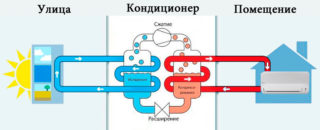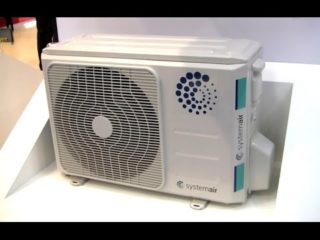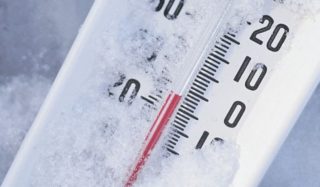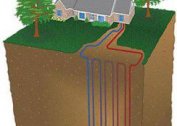The air-to-air heat pump is necessary for heating the heat carrier, which is installed in houses with converter heating. This approach is in increasing demand every year, since households do not freeze in their homes with the advent of cold weather and use unlimited quantities of hot water.
Equipment specifications
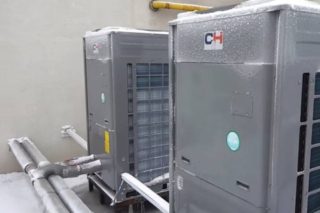
An air-to-air heat pump for heating a home is an alternative energy equipment. The task of such a heat pump is to collect heat from the air masses on the street and to heat residential and non-residential premises with it. For efficient and uninterrupted operation, you need to use some kind of combustible fuel.
Visually, the heat pump resembles an inverter air conditioner or a split system consisting of an inside building and an outdoor unit. The principle of operation is more like a refrigerator, only with the opposite effect.
The principle of operation and device
When developing the equipment, the physical phenomenon of thermodynamics formed the basis - during evaporation, the liquid cools the surface on which it is dispersed.
Refrigerators work by this principle. The internal cavity is equipped with tubes through which refrigerant circulates under high pressure. From the cavity of the freezer, it absorbs heat, while heating itself up a bit. The collected heat is released into the room.
For cooling, the refrigerant is compressed in the compressor. Freon in each working cycle changes its state of aggregation from gaseous to liquid and vice versa.
The air-to-air heat pump works according to a similar principle, only it absorbs heat not from a closed freezer, but from the street. Even if the window is minus temperature, the atmosphere contains thermal energy.
The equipment includes the following segments:
- a fan and a condenser for supplying heated air to the room;
- compressor;
- copper pipes for transporting freon between the house and the street;
- evaporator with forced air blower;
- expansion valve.
The compressor, expansion valve and evaporator with fan for forced blowing are part of the external unit, the remaining parts are intended for the internal part.
Advantages and disadvantages
Air heat pumps, like other types of equipment, have advantages and disadvantages.
The main advantages include:
- Universality of use. With the help of this type of equipment it is possible to heat and cool the premises.
- Ease of use. To operate the system, it is enough to set the required temperature regime. This can be done remotely using the remote control or directly on the display.
- Environmental friendliness. Thanks to such systems, a person has the opportunity to completely abandon the burning of firewood, coal, natural gas and other types of fuel that clog the environment with combustion products.
- Reasonable cost. Pricing policy allows you to purchase a heat pump for almost everyone. You can even build it yourself.
- Profitability. Air-to-air heat pumps have a high heat transfer coefficient with minimal energy costs. The equipment generates 4-5 kW of heat for each 1 kW of electricity consumed.
- Fire safety. For the production of heat there is no need to use flammable or fire hazardous compounds.Even irregularities in the operation of the system are not capable of causing a fire.
Owners of split systems distinguish the following disadvantages:
- in the absence of power supply, the system will not work, if the supply is unstable, it is recommended to install an additional generator;
- dust will hang in the air during the entire time the fans are running;
- when cooling, there is an increase in power consumption;
- the efficiency of the system depends on the outdoor temperature;
- a slight but still noisy background.
Air-to-air heat pumps are efficient in operation until the air temperature drops below -10 degrees. If a country house is built in a region with a cold climate, you also need to install a fireplace or boiler.
Pumps are controlled by integrated automation. Special attention is not required to configure and operate the equipment. It is only important to regularly and thoroughly clean the air filters and, if necessary, change them.
Differences from the air conditioner
Visually, the heat pump and air conditioning are similar, but the technical and design characteristics are different.
An external heat pump is used to heat rooms throughout the year. Air conditioning is mainly used to cool the room in the heat.
The main task of the heat pump is heating, but many models are also capable of cooling the air. However, in terms of energy efficiency, such systems are significantly inferior to air conditioners.
Air conditioners can also heat the air in the rooms, but in this case they consume a large amount of electricity, which can “hit hard” at the end of the month.
Selection and calculation of heat pump power
Thermal equipment "air-to-air" will be effective if it is correctly selected. It is necessary to preliminarily calculate the optimal power of the equipment taking into account the area of the room.
When carrying out the calculations, the energy efficiency coefficient is used - COP (ratio of the power of the heat pump to the energy used). For simple models, this indicator reaches no more than 5 points, and for expensive models - 8. If the air temperature in the street drops to -15 - -20 degrees, this coefficient will decrease equally for all models.
When calculating it is important to consider the following nuances:
- general climatic conditions in which the house is located;
- number of residents in a private house;
- quadrature of rooms;
- insolation and thermal insulation of rooms.
As a rule, for every 10 sq.m. about 0.7 kW of heat pump power is required. But this indicator is rather arbitrary. For example, if the ceiling height is more than 2.7 m or the windows and walls are not insulated, more heat will be required to heat the rooms.
It is recommended to purchase equipment from official representatives of trusted manufacturers or in large stores of household appliances, where the buyer will be provided with all quality certificates.
